Fabric inspection technology is critical to garment manufacturing as fabrics account for 50-60% of the total cost of a garment.
Fabric accounts for approximately 50-60% of the total cost of a garment and is critical to the entire process of garment manufacturing. Garment rejections/modifications due to weaving or knitting defects in the fabric can result in a significant loss of value for the company. Not only the defect identification process, but also marking the location of defects on the fabric and avoiding defects during mark making and subsequent cutting are important to provide defect-free garments.

The traditional way is through manual inspection. Manually lay the material flat on the table and mark the defects. In order to make the fabric easy to flow, the coiled material can be placed on the reel, which is convenient for the inspection of the coiled material.
Semi-automatic fabric inspection is an intelligent inspection method after manual inspection. The advantage of semi-automatic inspection machine is to provide electronic wheel encoder to measure the length of the inspected fabric and monitor the width of the fabric. While length measurements help determine ply count and length, the uniform width of the fabric maximizes fabric utilization. This mechanism allows the fabric to pass smoothly through the roller system (adjusted by tension) and then under the meter counter to the holding tube. The speed of the fabric on the inspection machine must not exceed 15 yards per minute, which is the ideal speed at which the operator can easily detect faults.
Over the past decade, the global textile industry has undergone tremendous technological change. An example of such advancements in the fabric inspection process is automated visual inspection systems. The most significant change is the shift from relying on the human eye to scanning with a CCD camera. The process is to record the location, size and image of the defect in the system. After inspection, the product is graded according to severity and finally undergoes precise cutting of the material. The purpose is to save manpower and time, and improve the accuracy of the inspection process.
Automated inspection systems are designed to improve the accuracy, consistency and speed of defect detection, not only in inspection but also in the fabric manufacturing process. Using automated technology for detection system has more advantages as it is faster and also eliminates high detection errors due to human weakness. More importantly, it can save labor costs by reducing the need for highly skilled inspectors.
AOL fabric CNC cutting machine is an equipment that can realize the integration of detection and cutting. It can check the material through CCD, and it also has an automatic feeding device, which can realize the integration of feeding, inspection and cutting.
AOL fully automatic computerized cutting system is specially designed for your mass production cutting needs, using a blade cutting machine for cutting, AOL fully automatic cutting machine provides precise results when running at high speed, easily producing a series of lines, shapes and arcs.
This high-precision cutting system will consistently and accurately cut any single-ply, low-ply and high-ply cutting job, offering maximum flexibility for virtually all industrial and technical fabrics currently used in the apparel, footwear, luggage, automotive and upholstery industries.
If you have anything else you want to know, please contact us by email or whatsapp+86 18560162709!







 No.5789, Yushan Road, Jinan City, Shandong Province, China
No.5789, Yushan Road, Jinan City, Shandong Province, China +86 18560162709
+86 18560162709 250109
250109








